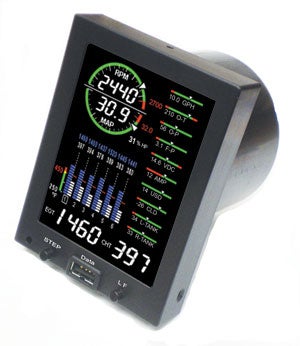J.P. Instruments has been a household name for owners of certificated aircraft, but now it is approaching the Experimental market with new vigor and, more importantly, a completely new product. Check out the EDM-740, an Experimental-only version of the company’s EDM-730 thats both innovative and, shall we say, aggressively priced. Got your attention?

At $2899 for a four-cylinder installation ($3250 for a six), the 740 includes sensors and channels for every system you could think to monitor. Indeed, in that base package, you’ll get most of the popular sensors. Electrical-bus current, turbine-inlet temp, carb temp and fuel pressure are optional. And while the device can read resistance or capacitance fuel-level senders, its up to the builder to provide them.
The 740 follows JPIs established engine-monitor traditions of stacked EGT and CHT readouts so you can watch all cylinders at once. One great feature is that when you choose four cylinders instead of the six shown in the photo above, the bar graphs are redrawn proportionally; there are no missing bars with the 740, thanks very much. You can choose the order of the subordinate menu items as well.
Making It Fit
A boon for retrofitters, the EDM-740 slithers into a 3.125-inch instrument hole; the barrel is offset and the display can be turned any side up. This feature allows you to mount it near existing instruments and avoid physical interference. Minus the connectors, the 740 is a mere 2 inches deep behind the panel. The faceplate is 4.23 inches tall and 3.195 inches wide.
Key features include user-defined redlines and alarms and a large single-line display that magnifies the values of other indications; you scroll through the displays choices with the STEP button. If you have ever used a conventional JPI engine monitor, the 740s methodology will be immediately familiar. Also on the front panel is the LF button, for Lean Find. In default mode, when you press LF once, the term ROP will appear, which means its entering the lean-find mode, expecting you to run the engine rich of peak EGT. (If you press and hold both buttons, you can select LOP for lean-of-peak operations; you can make this your default setting if you prefer.) In Lean Find, the monitor watches the EGTs rise and notes the first and last to peak. Once it has found peak, the bottom display line changes to show the current fuel flow and the temperature delta from peak of the controlling cylinder, all as an aid to leaning. In the LOP mode, the EGT bars form an icicle layout, descending from the top line, to show how far each cylinder is lean of peak EGT.
The EDM-740 also features an engine-power calculator, and here its done correctly: Rich of peak it uses mass airflow (manifold pressure x rpm, roughly), but lean of peak it uses fuel flow to calculate power.
In the Air
Lance Turk, designer of the first all-in-one engine monitor, the Vision Microsystems VM-1000, is now JPIs new-product guy. I had a chance to sample the EDM-740 in Turks Glasair I. Even cross-cockpit (Turk has the unit mounted in the small left subpanel) the 740s display is clear and legible right down to the smallest menu item. Notable are the fast-responding probes-during the several engine-leaning cycles we tried, the EGTs immediately followed movement of the mixture control, and the Lean Find function looked stable and easily digestible to a pilot who is busy doing other things (like flying). And those who want to track engine health will be excited to learn that the 740 includes integral data logging-it can absorb data at 6-second intervals for some 200 hours.
My exposure suggests that the EDM-740 will be an excellent choice for builders trying to squeeze the most into a tight panel and, particularly, for those updating older panels to the latest in electronic engine monitoring.
For more information, call 800/345-4574 or visit www.jpinstruments.com.





